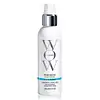What's inside
What's inside
 Key Ingredients
Key Ingredients

No key ingredients
 Benefits
Benefits

 Concerns
Concerns

 Ingredients Side-by-side
Ingredients Side-by-side

Water
Skin ConditioningBehentrimonium Methosulfate
Cetearyl Alcohol
EmollientCocos Nucifera Oil
MaskingPolyquaternium-37
Dipropylene Glycol
HumectantPhenoxyethanol
PreservativePropylene Glycol Dicaprylate/Dicaprate
EmollientC10-40 Isoalkylamidopropylethyldimonium Ethosulfate
Silicone Quaternium-18
EmollientCaprylyl Glycol
EmollientCeteareth-20
CleansingPPG-26-Buteth-26
Skin ConditioningTrideceth-12
EmulsifyingPEG-40 Hydrogenated Castor Oil
EmulsifyingTrideceth-6
EmulsifyingPPG-1 Trideceth-6
Skin ConditioningHydrolyzed Keratin
HumectantParfum
MaskingLaurdimonium Hydroxypropyl Hydrolyzed Keratin
Skin ConditioningCoumarin
PerfumingQuaternium-33
Benzyl Alcohol
PerfumingPotassium Sorbate
PreservativeWater, Behentrimonium Methosulfate, Cetearyl Alcohol, Cocos Nucifera Oil, Polyquaternium-37, Dipropylene Glycol, Phenoxyethanol, Propylene Glycol Dicaprylate/Dicaprate, C10-40 Isoalkylamidopropylethyldimonium Ethosulfate, Silicone Quaternium-18, Caprylyl Glycol, Ceteareth-20, PPG-26-Buteth-26, Trideceth-12, PEG-40 Hydrogenated Castor Oil, Trideceth-6, PPG-1 Trideceth-6, Hydrolyzed Keratin, Parfum, Laurdimonium Hydroxypropyl Hydrolyzed Keratin, Coumarin, Quaternium-33, Benzyl Alcohol, Potassium Sorbate
Water
Skin ConditioningAlcohol Denat.
AntimicrobialPolyurethane-14
Butylene Glycol
HumectantPEG-60 Hydrogenated Castor Oil
EmulsifyingPanthenol
Skin ConditioningTocopheryl Acetate
AntioxidantAscorbic Acid
AntioxidantUrtica Dioica Extract
AstringentAlcohol
AntimicrobialBiotinoyl Tripeptide-1
Oleanolic Acid
Skin ConditioningHydrolyzed Wheat Protein
Skin ConditioningNelumbo Nucifera Flower Extract
Skin ConditioningApigenin
AntioxidantAesculus Hippocastanum Seed Extract
Skin ConditioningHelichrysum Italicum Extract
AntiseborrhoeicAdansonia Digitata Fruit Extract
EmollientGlycerin
HumectantCaprylyl Glycol
EmollientHexylene Glycol
EmulsifyingPPG-26-Buteth-26
Skin ConditioningPEG-40 Hydrogenated Castor Oil
EmulsifyingAmp-Acrylates Copolymer
Sodium Laneth-40 Maleate/Styrene Sulfonate Copolymer
Triethyl Citrate
MaskingAminomethyl Propanol
BufferingTetrasodium Glutamate Diacetate
Phenoxyethanol
PreservativeEthylhexylglycerin
Skin ConditioningPotassium Sorbate
PreservativeParfum
MaskingHydroxycitronellal
PerfumingLinalool
PerfumingLimonene
PerfumingWater, Alcohol Denat., Polyurethane-14, Butylene Glycol, PEG-60 Hydrogenated Castor Oil, Panthenol, Tocopheryl Acetate, Ascorbic Acid, Urtica Dioica Extract, Alcohol, Biotinoyl Tripeptide-1, Oleanolic Acid, Hydrolyzed Wheat Protein, Nelumbo Nucifera Flower Extract, Apigenin, Aesculus Hippocastanum Seed Extract, Helichrysum Italicum Extract, Adansonia Digitata Fruit Extract, Glycerin, Caprylyl Glycol, Hexylene Glycol, PPG-26-Buteth-26, PEG-40 Hydrogenated Castor Oil, Amp-Acrylates Copolymer, Sodium Laneth-40 Maleate/Styrene Sulfonate Copolymer, Triethyl Citrate, Aminomethyl Propanol, Tetrasodium Glutamate Diacetate, Phenoxyethanol, Ethylhexylglycerin, Potassium Sorbate, Parfum, Hydroxycitronellal, Linalool, Limonene
Ingredients Explained
These ingredients are found in both products.
Ingredients higher up in an ingredient list are typically present in a larger amount.
Caprylyl Glycol is a humectant and emollient, meaning it attracts and preserves moisture.
It is a common ingredient in many products, especially those designed to hydrate skin. The primary benefits are retaining moisture, skin softening, and promoting a healthy skin barrier.
Though Caprylyl Glycol is an alcohol derived from fatty acids, it is not the kind that can dry out skin.
This ingredient is also used as a preservative to extend the life of products. It has slight antimicrobial properties.
Learn more about Caprylyl GlycolParfum is a catch-all term for an ingredient or more that is used to give a scent to products.
Also called "fragrance", this ingredient can be a blend of hundreds of chemicals or plant oils. This means every product with "fragrance" or "parfum" in the ingredients list is a different mixture.
For instance, Habanolide is a proprietary trade name for a specific aroma chemical. When used as a fragrance ingredient in cosmetics, most aroma chemicals fall under the broad labeling category of “FRAGRANCE” or “PARFUM” according to EU and US regulations.
The term 'parfum' or 'fragrance' is not regulated in many countries. In many cases, it is up to the brand to define this term.
For instance, many brands choose to label themselves as "fragrance-free" because they are not using synthetic fragrances. However, their products may still contain ingredients such as essential oils that are considered a fragrance by INCI standards.
One example is Calendula flower extract. Calendula is an essential oil that still imparts a scent or 'fragrance'.
Depending on the blend, the ingredients in the mixture can cause allergies and sensitivities on the skin. Some ingredients that are known EU allergens include linalool and citronellol.
Parfum can also be used to mask or cover an unpleasant scent.
The bottom line is: not all fragrances/parfum/ingredients are created equally. If you are worried about fragrances, we recommend taking a closer look at an ingredient. And of course, we always recommend speaking with a professional.
Learn more about ParfumPeg-40 Hydrogenated Castor Oil is derived from castor oil and polyethylene glycol (PEG). It is used as a emollient and emulsifier.
As an emulsifier, it helps prevent ingredients from separating. It also helps make the other ingredients more soluble; it is often used to solubilize fragrances. This increases spreadability and elongates shelf life in a product.
Emollients help soothe and soften the skin. They do this by creating a protective film on your skin. This barrier helps trap moisture and keeps your skin hydrated. Emollients may be effective at treating dry or itchy skin.
This ingredient may or may not be vegan, depending on the source.
Peg-40 Hydrogenated Castor Oil may not be fungal-acne safe. We recommend speaking with a professional if you have any questions or concerns.
Learn more about PEG-40 Hydrogenated Castor OilPhenoxyethanol is a preservative that has germicide, antimicrobial, and aromatic properties. Studies show that phenoxyethanol can prevent microbial growth. By itself, it has a scent that is similar to that of a rose.
It's often used in formulations along with Caprylyl Glycol to preserve the shelf life of products.
Potassium Sorbate is a preservative used to prevent yeast and mold in products. It is commonly found in both cosmetic and food products.
This ingredient comes from potassium salt derived from sorbic acid. Sorbic acid is a natural antibiotic and effective against fungus.
Both potassium sorbate and sorbic acid can be found in baked goods, cheeses, dried meats, dried fruit, ice cream, pickles, wine, yogurt, and more.
You'll often find this ingredient used with other preservatives.
Learn more about Potassium SorbateWe don't have a description for PPG-26-Buteth-26 yet.
Water. It's the most common cosmetic ingredient of all. You'll usually see it at the top of ingredient lists, meaning that it makes up the largest part of the product.
So why is it so popular? Water most often acts as a solvent - this means that it helps dissolve other ingredients into the formulation.
You'll also recognize water as that liquid we all need to stay alive. If you see this, drink a glass of water. Stay hydrated!
Learn more about Water